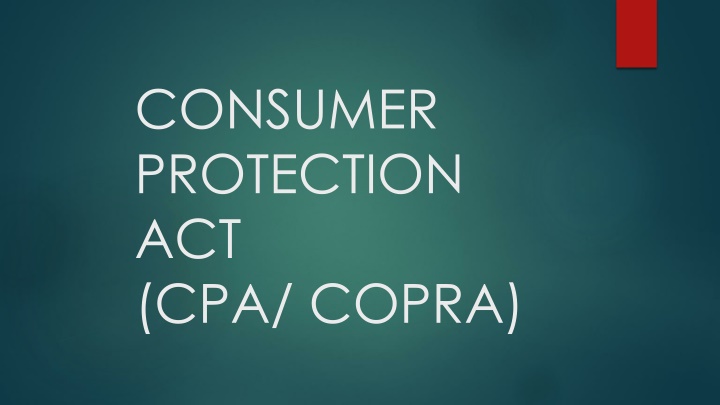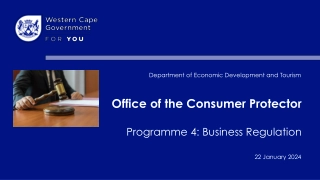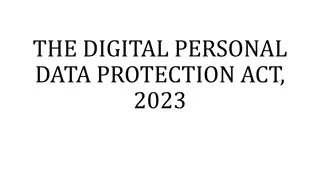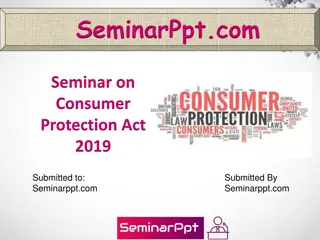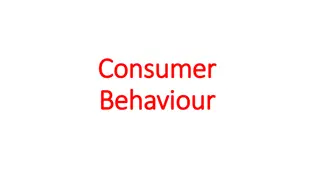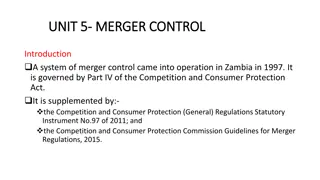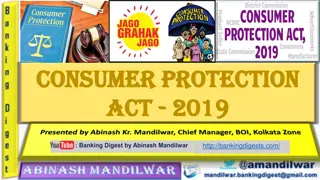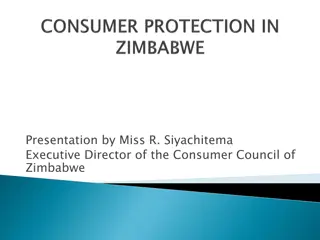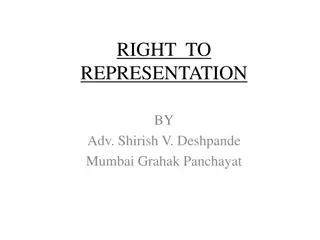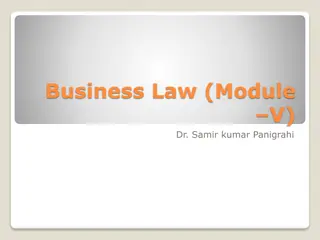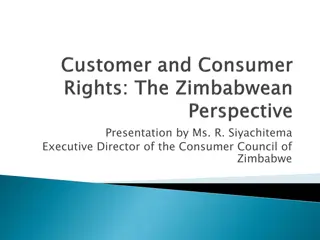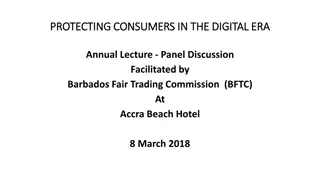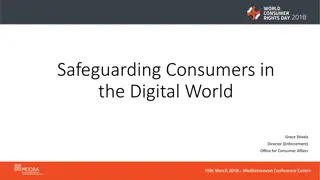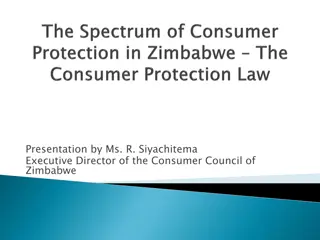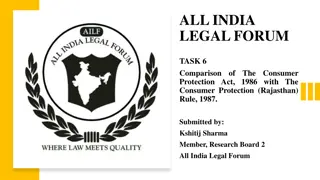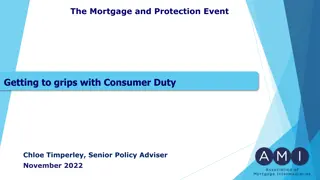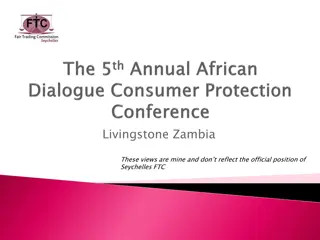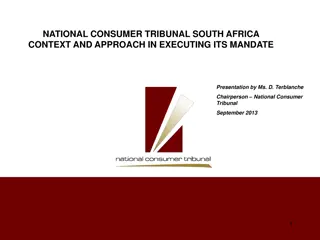Consumer Protection Act
The Consumer Protection Act (CPA/COPRA) is a significant legislation aimed at protecting consumer interests and resolving disputes. It covers goods and services, ensures speedy dispute resolution, and defines terms like complaint, deficiency, and service. Liability aspects, including criminal and civil liabilities, are also discussed, highlighting who is liable in different scenarios.
Download Presentation

Please find below an Image/Link to download the presentation.
The content on the website is provided AS IS for your information and personal use only. It may not be sold, licensed, or shared on other websites without obtaining consent from the author.If you encounter any issues during the download, it is possible that the publisher has removed the file from their server.
You are allowed to download the files provided on this website for personal or commercial use, subject to the condition that they are used lawfully. All files are the property of their respective owners.
The content on the website is provided AS IS for your information and personal use only. It may not be sold, licensed, or shared on other websites without obtaining consent from the author.
E N D
Presentation Transcript
CONSUMER PROTECTION ACT (CPA/ COPRA)
Introduction Initially Law of TORT; dealt with civil wrong. Consumer Protection Act 1986; came into force on 15thApril 1987. This is a welfare legislation mainly tilting towards the consumer.
Aims & Objectives better of the protection of the interests of the consumer and of settlements of consumer disputes. The Act applies to all goods & services. Provides speedy & inexpensive settlement of disputes within a limited time frame.
According to the Act: COMPLAINT means any allegation made by a complainant that the service hired or availed of or agreed to be hired or availed of by him, suffer from deficiency in any respect.
Deficiency: refers to any fault, imperfection, shortcoming, or inadequacy in the quality, nature & manner of performance which is required to be maintained under any law for the time being.
Service: service of any description which is made available to potential users & includes the provision of facilities in connection with banking insurance , etc. but does not include the rendering of any service free of charge or under a contract of personal service.
Liability Criminal liability: When doctor has committed an act of gross negligence. The pts. may die and the doctor gets jailed for at least two years. The offence is bailable. Civil liability: Under Indian Contract Act. Patient claims against the doctor. damages & compensation
Who is Liable ? WHO IS LIABLE Doctors/ Hospitals paid by an insurance firm for treatment of a client. Doctors with independent practice rendering only fee services. All hospitals having free as well as paying patients. Private hospitals charging all.
Not liable Doctors in hospitals who do not charge their patients. Hospitals patients. offering free services to all
Damages Damages denote monetary compensation awarded to the plaintiff by the process of law. Two types- Pecuniary damages- money. Non- pecuniary damages- pain & suffering. 1. 2.
The Act envisages a three-tier quasi-judicial machinery : 1. District Consumer Disputes Redressal Forum at District level. 2. State Consumer Disputes Redressal Commission at State level. 3. National Consumer Redressal commission level. Disputes National at
Procedure For Lodging Complaint With or without a lawyer and paying a nominal fees District level: damages upto 5 lakhs; District judge. State level: damages 5 20 lakhs; High court judge. National level: damages more than 20 lakhs; Supreme court judge.
Who can sue the doctor ? Patient himself Registered consumer organization State or Central govt. The legal representative
Time limit for complaint Two years from the date of injury. The time starts from the date of injury and not from the date of disability certificate. However, if the injury is continuous then the time starts from the date of last treatment given.
Major issue in complaint is negligence. The elements of negligence include:- Duty to care Violation of duty Resultant injury
Preventive steps against Litigation SOME DO s: 1. Mention pads. 2. Date & time of consultation. 3. Age, sex & weight (if child). 4. Record precise case history & physical findings. 5. If pts. Refuse investigation/ treatment, take a written note from pts. qualifications on prescription
Mention condition of pts. In specific/ objective terms. Record history of drug allergy. Mention additional precautions. Explain the prognosis. Mention use of alcohol / drugs. Advise X- rays if required.
DONTS: Do colleagues. Do not hesitate to discuss case with patients. Do not allow substitution. Do not examine a patient if you are under the effect of alcohol, drugs or exhausted. Never talk loose of your colleagues. If the pts. Incite, politely clear their queries. Do not experiment on pts. not hesitate to discuss case with
Never Examine a female patient without presence of female attendant/nurse Don t be overconfident Don t refuse if the patient wants to leave against medical advice, It is their right, document this properly. Don t leave at the moment of death
What to do when sued ? If you receive a summon or a legal notice then do the following - Inform your insurance company at the earliest. Keep a photocopy of the papers received, and send the originals to the insurance firm. Summarize the treatment given by writing the same on a fresh pad. Make copy of complete record and lock the originals in a safe place. Tell your staff about the suit and tell them not to tell anyone further on.
Do NOT do the following- Tell the patient that you are insured. Offer a settlement until your insurance company asks you to do so, unless your case is very weak. Alter your patients records. Offer a specialist fee. Discuss about the patients treatment. Admit guilt or fault to anyone. Contact any consultant about the case. Agree to treat the patient during the pendency of the case.
Consent Defined as* When two or more persons agree upon the same thing in the same sense, they are said to consent. *as per the definition given in section 13 of Indian Contract Act, 1872. Can be obtained from patient / relative / attendant.
Consent can be given by any person who is conscious, mentally sound and is of above the age of 12 years. But due to legal drawbacks it is advisable that consent only be taken from patients who are above the age of 18 years. Consent given under fear, fraud or mis-representation of facts, or by a person who is ignorant of the implications of consent, or who is under12 yrs. Age, is INVALID (sec. 90 I.P.C.)
Types of Consent Implied Consent: Most common. Allows inspection, palpation, percussion, auscultation and routine sonography. Withdrawal of blood for diagnostic purposes requires written consent.
Express consent: Anything other than the implied consent. May be oral or written. Oral consent for minor examination. Written consent for- Major diagnostic procedures G.A. Surgical operations Intimate examination Medico- legal cases
Informed consent: For understand the procedure to which thy gave consent. Information must be explained in non- medical terms, preferably in the local language. pts. who alleged that they did not
Proxy consent: All the above can take the shape of proxy consent. Parent for child; close relative for mentally unsound; etc.
Avoid High- risk situations like Certain medical conditions in children. Retention of objects in operation sites. Accident & emergency department. Extraction of the wrong tooth/ amputation of the wrong limb. Emergency, Orthopedics, Surgery, Plastic surgery. Anesthesia.(cerebral damage from hypoxia due to insufficient oxygen.) Therapeutic hazards. Failure of communication. 1. 2. 3. 4. 5. 6. 7. 8.
MOST COMMON ALLEGATIONS IN DENTISTRY Slipping of instrument Broken needle Extraction of wrong tooth Injury in fitting or ill- fitting plates and dentures Fracture/ dislocation of jaw during treatment Infection from unsterile instruments Leaving the broken root in the socket Death from anesthesia
Preventive Measure True and MCI/DCI approved qualification Communication/Interpersonal behavior Academic & technical upgradation Medical/Dental ethics and laws Prevention by professional indemnity (Insurance cover)
